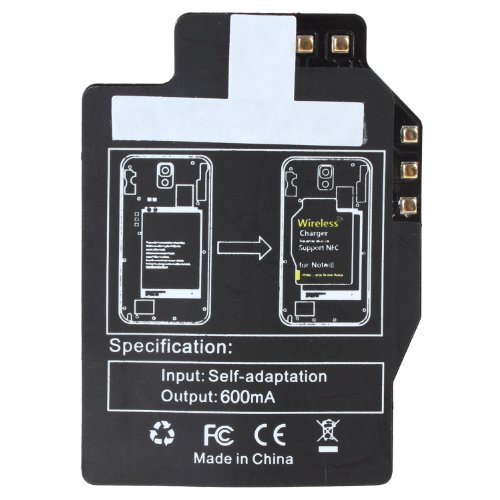A few months ago, I asked if we could entirely do away with physical ports on phones. We have Bluetooth to replace the headphone port, WiFi can replaced the data transfer properties of the USB port, all that's needed is a way to get power into the damn thing! That's what the "Qi" standard hopes to change. A simple way to get inductive charging working on phones.
So, thanks to some Amazon vouchers I got for my birthday, I decided to see how cheaply and easily I could get wireless charging working on my phone. Here's how I Qi'd up my kit for under £14.
The Receiver
If your phone doesn't come with Qi, you'll need a Qi receiver. A small circuit which can attach to your phone. Prices on Amazon range from £4 to £40. I bought a £6.49 one which also included NFC compatibility.

Attaching the Qi receiver was really simple. Pop the back off the phone, peal off the receiver's sticker, line up the contacts, replace the cover. Done in 10 seconds.

The Pad
Charging mats on Amazon range from about a fiver - up to £30. I picked a smallish one which also came with two extra USB charging ports for £7.

To charge the phone, simply place it on the mat. Then subtly reposition it until the coil is directly above the mat's charging circuit. Then try not to nudge the phone, lest you disturb the charging.
To be fair, the mat has a blue LED which illuminates once charging commences. The phone (depending on model) will also vibrate or play a sound to indicate that it's charging.
And, really, that's it. Deceptively simple. In an ideal world, every surface of your home would have an inductive charging loop built in. Throw the phone down on a desk or bookshelf and let it trickle charge whenever you're not using it. Just before falling asleep, it's much easier to place the phone on a mat than find and fiddle with a wire.
There's only one problem. It's slow!
Speed
This is the big fly in the ointment for Qi. It's perfectly suitable for charging overnight, or for when the phone is idle. It's not so good when you're actually trying to use the device.
Here's what a battery monitor reported the charging current as.

640mA really isn't very good. By contrast, when plugged directly into the official Samsung charger, the current is 1,800mA. Twice as fast basically. As I said, Qi is fine when the phone is idle, but 640mA is inadequate if you're using the phone.
For example, I also bought a Qi Car Charger, for £30.

In theory, it's great. I can just plonk the phone in the holder and not have to fumble for a wire. The problem is, I (legally) use my phone while driving. I've got Google Maps directing me around traffic and I've got my PodCast player streaming over Bluetooth. This means my screen is always on and the cellular and Bluetooth radios are working full time.
This power draw means that the battery just doesn't charge over Qi. Or rather, the charge and discharge rate are roughly the same.
Here's a typical reading from the power monitor. After an hour of commuting, my battery's power level hasn't appreciably changed.

If I'm lucky, the battery will have risen a percent or two over an hour. That's quite disappointing.
On the plus side, with this specific charger, the USB cable is easily accessible if I do want to charge directly.
Overall
The Qi Standard is pretty nifty. Wireless charging is surprisingly convenient for those occasions where you want to just place a phone down and not have to worry about whether the wire is USB, Lightning, or crocodile clips.
The physics behind this kind of inductive charging really do place some limits on the power levels which can safely be achieved. I've noticed my phone gets noticeably warmer when charging via Qi than by standard USB.
Qi receivers and transmitters are now very cheap - so hopefully we'll start seeing more phones incorporating this by default.
One thought on “Qi on the Cheap”
Tim H
My bug bear with this is always around efficiency. What is the additional power required when we have billions of these less efficient chargers being used?
What links here from around this blog?